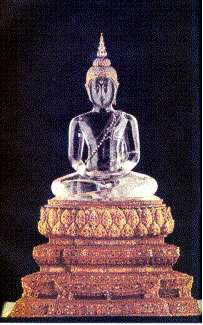House of Na Champassak
The Na Champassak family (Lao: ນະ ຈຳປາສັກ; Thai: ณ จัมปาศักดิ์, rtgs: Na Champasak) were an important Lao Royal family, descendants of Chao Yuttithammathon (Kham Souk), the 11th King of the Kingdom of Champassak whose prominent members include Prince Boun Oum Na Champassak and Prince Sisouk na Champassak. The Na Champassak family was the ruling house of the former Kingdom of Champassak, with territories reaching on both banks of the Mekong river.

History
To repel the attempts of Setthathirath II, nephew of King Suliyavongsa, to unify the kingdom of Lanxang to include Vientiane and Loungprabang, the King of Loungprabang requested aid from Siam. The King of Siam therefore granted Loungprabang independence from Lanxang. Following in the footsteps of his cousin the King of Loungprabang, the Prince Nokasat Song, refused to acknowledge the rule of Setthathirath II. A grandson of King Suliyavongsa, the prince had left Vientiane for Southern Laos upon the return of Setthathirath II. He asked the King of Siam to recognize Champassak's independence from Lanxang. Lanxang was thus split yet even further into a total of three small kingdoms.
During the rule of King Anouvong of the Kingdom of Vientiane, Anouvong placed his son Prince O on the throne of Champassak. During King Anouvong's rebellion against Siam, the former royals of Champassak started a rebellion against Prince O while he was fighting against Siamese forces in Issan. Returning to Champassak, Prince O saw a rebellion taking place and barely escaped out of the city. This escape was cut short after the former rulers tracked down Prince O and handed him over to the Siamese. The King of Siam returned the former royal family to rule over Champassak.
The name Champassak was given by Vajiravudh, the King of Siam, to descendants of Chao Yuttithammathon (Kham Souk), the 11th king of the Kingdom of Champassak. They took their name from the city of Champassak, prefixed by the nobiliary particle na signifying of a former kingdom or tributary state of Siam.[1] They are descended from the rulers of the Kingdom of Champassak and are also members of the Khun Lo Dynasty, which was established by Khun Lo. Originally, it was transliterated in English as Na Champasakdi.[2] During most of the 19th century the Kingdom of Champassak were tributary to Bangkok but was not an integral part of Siam.
Power and Wealth
The Champassaks were one of the most important and the wealthiest families in Laos.[3] Along with other leading families of Southern Laos and Chinese businessmen working in the opium trades, they dominated political and economic life in South Laos. At the time they were the national symbol and rallying point of the Laotian right centered around Prince Boun Oum na Champassak.
Notable members
- King Ratsadanay, last King of Champassak. Died Bassac, June 1946.
- Chao Boun Oum na Champassak, Prime Minister of Laos. Died in 1981, in France
- Prince Sisouk na Champassak -Former Finance and Defence Minister, Secretary General of the Royal Government of Laos. Author of Storm over Laos. Died in 1985, in Santa Ana, California, USA.
- Barbara Hutton - ex-wife of Raymond Doan, an adopted member of the Na Champassak.[4]
References
- ↑ "Royal Institute Dictionary". Royal Institute of Thailand. 1999. Retrieved January 15, 2012.
ณ ๒ [นะ] บ. ใน, ที่, เป็นคําบ่งเวลาหรือสถานที่ว่า ตรงนั้นตรงนี้, ถ้าใช้ นําหน้าสกุล หมายความว่า แห่ง เช่น ณ อยุธยา ณ ระนอง
. - ↑ http://www.amed.go.th/AboutUs/palace/nameH.htm
- ↑ http://astheysawit.info/12003-1975-laos.html
- ↑ http://www.royalark.net/Laos/champasa.htm
External links
- Christopher Buyers (August 2001 – October 2009). "Champasakti". The Khun Lo Dynasty Genealogy. The Royal Ark. Retrieved March 3, 2012.
All materials contained in this site are the subject of copyright. Many items are in use under licence. Therefore, on no account may copies be made of text, photographs, graphics or any other materials, without the express written consent of the site owner.